A British comic is a periodical published in the United Kingdom that contains comic strips. It is generally referred to as a comic or a comic magazine, and historically as a comic paper.
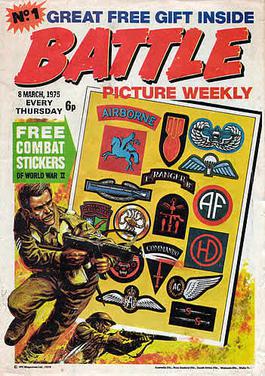
Battle Picture Weekly was a British weekly boys' war comic published by IPC Magazines from 8 March 1975 to 23 January 1988, when it merged with the new incarnation of Eagle after 644 issues. Most stories were set in World War II, with some based on other conflicts, while factual features also focused on warfare.

Tiger was a weekly British comics periodical published by Amalgamated Press, Fleetway Publications and IPC Magazines from 11 September 1954 to 30 March 1985. The title was initially launched in a large tabloid size to mimic newspapers; while it featured some action-adventure stories Tiger contained a large number of sport strips. The most famous of these was "Roy of the Rovers", which debuted in the first issue and was the comic's most popular feature, eventually transferring to its own comic in 1975. Tiger would go on to become one of the company's longest-running titles, notching 1573 issues before being merged with Eagle in 1985. Over the course of its run, Tiger featured columns by numerous famous sports figures, including Ian Botham, Geoff Boycott, Tony Greig, Trevor Francis, and Charlie Nicholas.
The Amalgamated Press (AP) was a British newspaper and magazine publishing company founded by journalist and entrepreneur Alfred Harmsworth (1865–1922) in 1901, gathering his many publishing ventures together under one banner. At one point the largest publishing company in the world, AP employed writers such as Arthur Mee, John Alexander Hammerton, Edwy Searles Brooks, and Charles Hamilton. Its subsidiary, the Educational Book Company, published The Harmsworth Self-Educator, The Children's Encyclopædia, and Harmsworth's Universal Encyclopaedia. The company's newspapers included the Daily Mail, the Daily Mirror, The Evening News, The Observer, and The Times. At its height, AP published over 70 magazines and operated three large printing works and paper mills in South London.
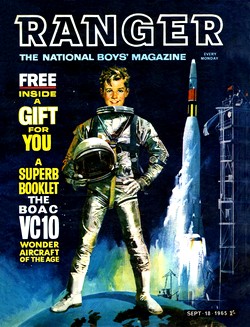
Ranger was a weekly British comics periodical published by Fleetway Publications from 18 September 1965 to 18 June 1966. Intended as an educational publication, the cover described it as "The National Boys' Magazine" and the content mixed comic strips with a much larger quotient of factual articles than most other Fleetway children's titles of the time. Ranger lasted 40 issues before being merged with Fleetway's fellow educational title Look and Learn in 1966.

Lion was a weekly British comics periodical published by Amalgamated Press from 23 February 1952 to 18 May 1974. A boys' adventure comic, Lion was originally designed to compete with Eagle, the popular weekly comic published by Hulton Press that had introduced Dan Dare. It debuted numerous memorable characters, including Captain Condor, Robot Archie, Paddy Payne and the Spider. Lion lasted for 1,156 issues before being merged with stablemate Valiant.

The Comet was a weekly British comics periodical published by J.B. Allen and later Amalgamated Press and Fleetway Publications from 20 September 1946 to 17 October 1959. Initially a children's newspaper, The Comet was transformed into a boys' adventure comic in May 1949 by editor Edward Holmes when J.B. Allen were purchased by Amalgamated Press. Also known as Comet Comic, The Comet Adventure Weekly, Comet Weekly and simply Comet as various points the title continued until October 1959, reaching 580 issues before being merged with another AP boys' comic, Tiger.
Playhour was a British children's comics magazine published by Amalgamated Press/Fleetway/IPC between 16 October 1954 and 15 August 1987, a run of approximately 1,700 weekly issues. Playhour contained a mixture of original tales for young children and adaptations of well-known fairy tales.
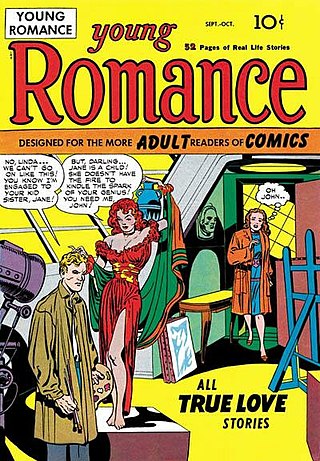
Romance comics is a comics genre depicting strong and close romantic love and its attendant complications such as jealousy, marriage, divorce, betrayal, and heartache. The term is generally associated with an American comic books genre published through the first three decades of the Cold War (1947–1977). Romance comics of the period typically featured dramatic scripts about the love lives of older high school teens and young adults, with accompanying artwork depicting an urban or rural America contemporaneous with publication.
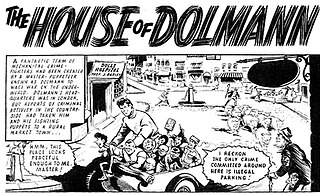
"The House of Dolmann" is a British comic strip published by Fleetway Publications and later IPC Magazines in the boys' comic anthology title Valiant between 29 October 1966 to 11 April 1970, with a brief revival from 7 September to 26 October 1974. Written by Tom Tully and primarily illustrated by Eric Bradbury, the strip centred on the exploits of genius inventor Eric Dolmann and his army of crime-fighting robot 'puppets'.

Josep Maria Beà i Font, in Spanish José Beá is a Spanish comic book artist.

Princess Tina was a weekly British girls' comic published from autumn 1967 to summer 1973 by the International Publishing Company, initially under the Fleetway Publications banner. Two comics, Princess and Tina, were merged to form Princess Tina; another title, Penelope, was merged into Princess Tina in 1969; the publication itself came to an end when it was merged into Pink.
British girls' comics flourished in the United Kingdom from the 1950s through the 1970s, before beginning to decline in popularity in the 1980s and 1990s. Publishers known for their girls' comics included DC Thomson and Fleetway/IPC. Most titles appeared weekly, with the content primarily in picture-story format. The majority of the stories were serialized, with two or three pages per issue, over eight to twelve issues. They were marketed toward young teen girls.
School Friend was the name of two different British weekly publications marketed toward girls, both of which were pioneering in their respective categories. The first School Friend, published from 1919 to 1929, was the first story paper marketed exclusively to girls. The second School Friend, published from 1950 to 1965, is considered the first British girls' comic. Although both published by Amalgamated Press, and both marketed toward girls, the content of the two publications was not directly related.

Girls' Crystal was a British weekly story paper and then a comic book published by Amalgamated Press (AP) that ran from 1935 to 1963. Along with School Friend and Girl, it was one of the first British girls' comics.
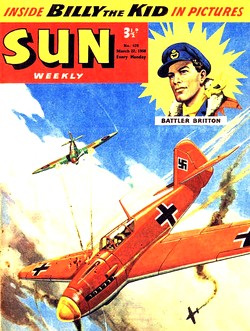
Sun was a weekly British comics periodical published by J. B. Allen, Amalgamated Press and Fleetway Publications between 11 November 1947 and 17 October 1959. During this time it was also known as Sun Comic, Sun Adventure Weekly, The Cowboy Sun Weekly, The Cowboy Sun, The Sun and Sun Weekly at various points, and ran for 551 issues before merging with Lion.
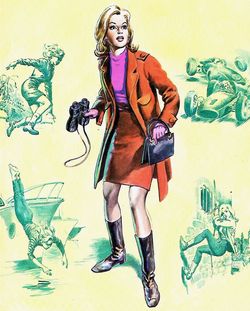
Jane Bond is a British comic character who has appeared in the strip "Jane Bond - Secret Agent", published by Fleetway Publications and IPC Magazines. The character, a globetrotting secret agent, first appeared in the girls' anthology title Tina on 25 February 1967, drawn by Mike Hubbard. After Tina was cancelled "Jane Bond - Secret Agent" continued in the merged Princess Tina until 1970.
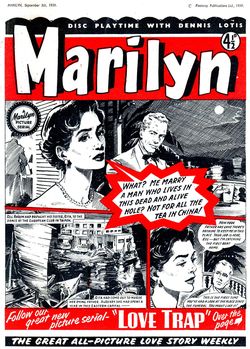
Marilyn was a British girls romance comic published weekly by Amalgamated Press and Fleetway Publications between 19 March 1955 and 18 November 1965. It ran for between 547 and 549 issues before merging with Valentine.

Valentine was a British girls romance comic published weekly by Amalgamated Press, Fleetway Publications and IPC Magazines between 19 January 1957 and 9 November 1974. It ran for 922 issues before merging with Mirabelle.

Eagle, sometimes referred to as The New Eagle and known at various points in its' life as Eagle and Scream!, Eagle and Tiger, Eagle and Battle, Eagle and M.A.S.K. and Eagle and Wildcat, was a British boys' adventure comic published by IPC Magazines from 27 March 1982 to January 1994. A revival of the famous Eagle, the title was initially as a weekly publication until turning into a monthly in May 1991. The title was finally cancelled in January 1994, after 505 issues.















